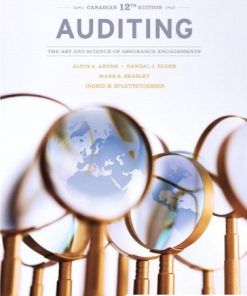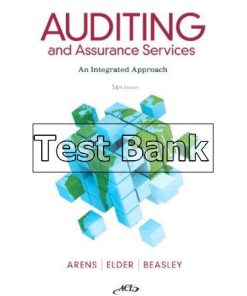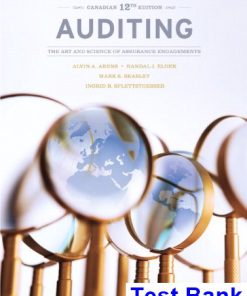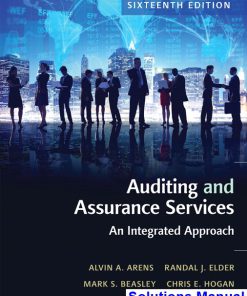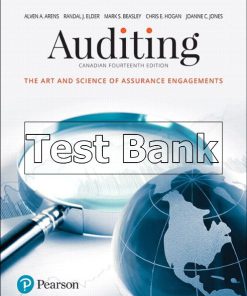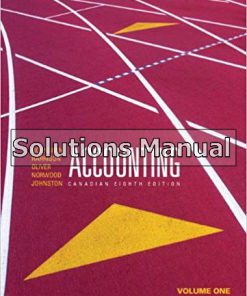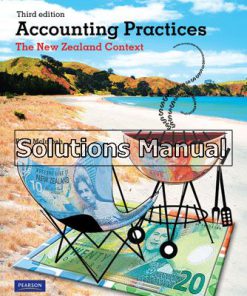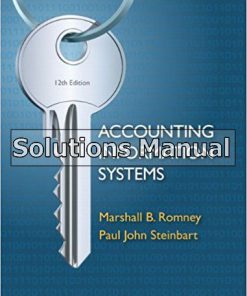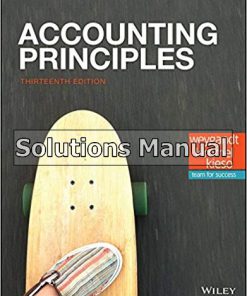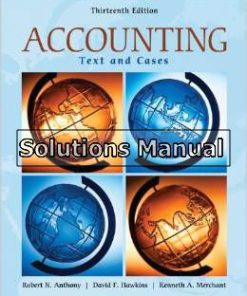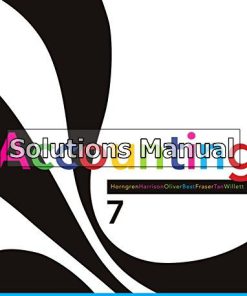Auditing The Art and Science of Assurance Engagements Canadian 14th Edition Arens Solutions Manual
$26.50$50.00 (-47%)
Auditing The Art and Science of Assurance Engagements Canadian 14th Edition Arens Solutions Manual.
You may also like
This is completed downloadable of Auditing The Art and Science of Assurance Engagements Canadian 14th Edition Arens Solutions Manual
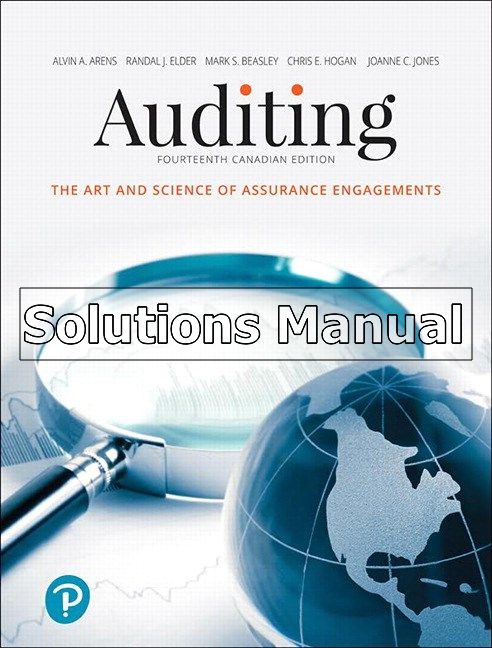
Product Details:
- ISBN-10 : 013483643X
- ISBN-13 : 978-0134836430
- Author:
As the world shifts to a greater reliance on digital media, it is appropriate that this text evolves as well. This fifteenth edition is the first fully digital version of Auditing and Assurance Services. Instructors and students will find that, although the medium has changed, the content is fully consistent with prior editions. This ISBN is for the Pearson eText and may not include any media, website access codes, or print supplement. Auditing: The Art and Science of Assurance Engagements is an introduction to auditing and assurance services. It is intended for use in an introductory auditing course, for one-semester or two-semester instruction at the undergraduate or graduate level. The book’s primary emphasis is on the auditor’s decision-making process in a financial statement audit and, to a lesser degree, other types of audits and assurance engagements
Table of Content:
- Chapter 1 The Demand for Audit and Other Assurance Services
- Introduction
- What are Assurance Engagements?
- What is Auditing?
- Report
- Why are Audits and Other Assurance Engagements Needed?
- Reducing Information Risk
- Common Types of Assurance Engagements
- Types of Auditors
- Accounting vs. Auditing
- Assurance and Nonassurance Services Offered by Public Accountants
- Nonassurance Services Offered by Public Accounting Firms
- Summary
- Review Questions
- Multiple Choice Questions
- Discussion Questions and Problems
- Professional Judgment Problems and Cases
- Applying Your Professional Judgment to Hillsburg Hardware
- Chapter 2 The Public Accounting Profession and Audit Quality
- Introduction
- An Overview of the Canadian Public Accounting Industry
- Public Accounting Firms
- Structure of Public Accounting Firms
- Requirements to be a Public Accountant
- Organizations Affecting the Canadian Public Accounting Profession
- Provincial CPA Organizations
- Public Company Accounting Oversight Board (PCAOB)
- Provincial Securities Commissions
- CPA Canada Assurance Standards
- Principles Underlying the Financial Statement Audit
- Personal Responsibilities
- Performance Responsibilities
- Reporting Responsibilities
- The Drivers of Audit Quality
- Quality Control
- Summary
- Review Questions
- Multiple Choice Questions
- Discussion Questions and Problems
- Professional Judgment Problems and Cases
- Applying Your Professional Judgment at Hillsburg
- Chapter 3 Professional Ethics and Legal Liability
- Introduction
- Professional Ethics and Public Accountants
- A Framework for Ethical Reasoning
- Obtain Relevant Facts and Identify the Ethical Issues
- Consider and Evaluate Courses of Action
- Ethical Blind Spots
- Professional Guidance on Ethical Conduct
- Public Protection
- Professional Colleagues
- The Independence Standard for Assurance Engagements
- Identify Threats
- Evaluate the Significance of the Threat
- Enforcement of the Code of Professional Conduct
- The Expectations Gap
- Reducing the Expectations Gap
- Audit Failure and Audit Liability
- Major Sources of Auditor Liability
- How Public Accountants Can Minimize Litigation Risk
- Summary
- Review Questions
- Multiple Choice Questions
- Discussion Questions and Problems
- Professional Judgment Problems and Cases
- Applying Your Professional Judgment to Hillsburg Hardware
- Chapter 4 Audit Responsibilities and Objectives
- Introduction
- Management’s Responsibilities
- Responsibilities of those Charged with Governance
- Auditor’s Responsibilities
- Auditors’ Responsibilities for Detecting Material Misstatements
- Auditor’s Responsibility for Related-Party Relationships and Transactions
- Auditor’s Responsibility to Consider Laws and Regulations
- Auditors’ Responsibility to Evaluate Going Concern
- Framework for Professional Judgment
- Professional Skepticism
- Financial Statement Cycles
- Cycle Approach to Segmenting an Audit
- Relationships Among Cycles
- Gather Sufficient and Appropriate Evidence
- Management Assertions
- Assertions About Classes of Transactions and Events
- Assertions About Account Balances
- An Overview of the Audit Process
- Client Acceptance
- Assess Risk of Material Misstatement
- Perform Risk Responses
- Summary
- Review Questions
- Multiple Choice Questions
- Discussion Questions and Problems
- Professional Judgment Problems and Cases
- Applying Your Professional Judgment to Hillsburg
- Chapter 5 Audit Evidence
- Introduction
- Nature of Audit Evidence
- Audit Evidence Decisions
- Persuasiveness of Evidence
- Sufficiency
- Combined Effect
- Types of Audit Procedures
- General Categories
- Inspection
- External Confirmation
- Analytical Procedures
- Use of Automated Tools and Techniques
- Appropriateness of Types of Procedures
- Cost of Types of Evidence
- Terms Used in Audit Procedures
- Design Analytical Procedures
- Compare Client and Industry Data
- Compare Client Data with Similar Prior-Period Data
- Compare Client Data With Client-Determined Expected Results
- Compare Client Data With Auditor-Determined Expected Results
- Precision of the Analytical Procedures
- Use of Audit Data Analytics and Advanced Technologies
- Planning, Performing, and Drawing Conclusions from ADAs
- Advanced Technologies
- Challenges for Auditors
- Documentation
- Contents and Organization
- Preparation of Working Papers
- Ownership of Working Papers
- Professional Skepticism, Evidence, and Documentation
- Appendix 5A: Common Financial Ratios
- Summary
- Review Questions
- Multiple Choice Questions and Task-Based Simulations
- Discussion Questions and Problems
- Professional Judgment Problems and Cases
- Applying Your Professional Judgment to Hillsburg Hardware
- Chapter 6 Client Acceptance, Preliminary Planning, and Materiality
- Introduction
- Planning for What Can Go Wrong
- Client Acceptance and Continuance
- Decide to Accept or Continue the Audit Engagement
- Consider Relevant Ethical Requirements
- Identify the Purpose of the Financial Statements
- Obtain an Understanding of the Terms of the Engagement
- Overall Audit Strategy
- Understand the Entity and Its Environment and the Applicable Accounting Framework
- Organizational Structure and Ownership
- Business Model
- Performance Measures
- Risk Assessment Procedures and Information from Other Sources
- Inquiries of Management and Others Within the Entity
- Analytical Procedures
- Observation and Inspection
- Preliminary Analytical Review
- Materiality
- Determine Overall Materiality
- Select the Benchmark
- Determine the Benchmark Percentage
- Justifying the Materiality Decisions
- Determine Performance Materiality
- Determine Specific Materiality
- Applying Materiality—Evaluating Results and Completing the Audit
- Forming an Overall Opinion and Reporting
- Summary
- Review Questions
- Multiple Choice Questions and Task-Based Simulations
- Discussion Questions and Problems
- Professional Judgment Problems and Cases
- Applying Your Professional Judgment to Hillsburg Hardware
- Chapter 7 Risk Assessment and Inherent Risk
- Introduction
- The Audit Risk Model
- Inherent Risk Assessment
- Identifying and Assessing Overall Financial Statement Risks
- Identifying and Assessing Risk of Material Misstatement at the Assertion level
- Identify Significant Risks
- Risk Response for Levels of Risk
- Considering Fraud Risk
- Discussions Among Audit Team
- Conditions for Fraud
- Risk Factors for Misappropriation of Assets
- Risk Response for Fraud Risks
- Responses to Address Management Override of Controls
- Summary
- Review Questions
- Multiple Choice Questions and Task-Based Simulations
- Discussion Questions and Problems
- Professional Judgment Problems and Cases
- Applying Your Professional Judgment to the Hillsburg Audit
- Chapter 8 Understanding the Internal Control System
- Introduction
- Internal Control Objectives
- Management’s Responsibility for Internal Control
- Auditors Responsibilities for Internal Control
- COSO Components of Internal Control
- Control Environment
- Risk Assessment
- Monitoring
- Information System and Communication
- Control Activities
- Internal Controls Specific to Information Technology
- Application Controls
- Impact of Information Technology on the System of Internal Control
- Type of Applications and Data Management Systems
- Complexity of Underlying IT Infrastructure
- Impact of Emerging Technologies on Internal Control
- Internet of Things and Peripheral Devices
- Smart Contracts and Blockchain
- Machine Learning and Artificial Intelligence (AI)
- Understanding Controls of Small Businesses
- Summary
- Review Questions
- Multiple Choice Questions and Task-Based Simulations
- Discussion Questions and Problems
- Professional Judgment Problems and Cases
- Applying Your Professional Judgment to Hillsburg Hardware
- Chapter 9 Control Risk Assessment
- Introduction
- Understand and Evaluate Internal Control
- Risk Assessment Procedures
- Documenting the System of Internal Control
- Evaluate System of Internal Control
- Control Risk Assessment
- Audit Approach
- Tests of Controls
- Types of Procedures
- Extent of Tests
- Changes in the IT System
- Auditor Reporting on Internal Control
- Reporting on Internal Controls for Some Public Companies
- Summary
- Review Questions
- Multiple Choice Questions and Task-Based Simulations
- Discussion Questions and Problems
- Professional Judgment Problems and Cases
- Applying Your Professional Judgment to Hillsburg Hardware
- Chapter 10 Risk Response: Audit Strategy, Overall Approach, and Audit Program
- Introduction
- Overall Audit Strategy
- Overall Audit Strategy
- Audit Plan and Audit Procedures
- Further Audit Procedures
- Appropriate Mix of Audit Procedures and Audit Approach
- Comparison of Different Mixes of Audit Procedures
- Design Effective Further Audit Procedures
- Nature of Audit Procedures
- Timing of Audit Procedures
- Design Audit Programs
- Summary
- Review Questions
- Multiple Choice Questions and Task-Based Simulations
- Discussion Questions and Problems
- Professional Judgment Problems and Cases
- Applying Your Professional Judgment to Hillsburg Hardware
- Chapter 11 Audit Sampling Concepts
- Introduction
- Selecting Items to Test and Sampling
- Representative Sampling and Its Risks
- Statistical vs. Nonstatistical Sampling and Probabilistic vs. Nonprobabilistic Sample Selection
- Probabilistic vs. Nonprobabilistic Sample Selection
- Sample Selection Methods
- Nonprobabilistic Sample Selection
- An Overview of the Audit Sampling Process
- Using Sampling for Tests of Controls
- Select the Sample and Perform Audit Procedures
- Conclude on Acceptability of the Population
- Statistical Sampling for Tests of Controls
- Sampling Distribution
- Using Sampling for Substantive Tests of Details
- Nonstatistical Sampling for Substantive Tests
- Define Population Characteristics
- Determine Initial Sample Size
- Evaluate the Sample Results
- Conclude on Acceptability of Population
- Statistical Sampling for Substantive Tests of Details
- The Pros and Cons of Monetary Unit Sampling
- Audit Data Analytics vs. Sampling
- Adequate Documentation and Professional Judgment
- Summary
- Review Questions
- Multiple Choice Questions and Task-Based Simulations
- Discussion Questions and Problems
- Professional Judgment Problems and Cases
- Applying Your Professional Judgment to Hillsburg Hardware
- Chapter 12 Audit of the Revenue Cycle
- Introduction
- Overview of the Revenue Process
- Processing Customer Orders
- Shipping Goods
- Billing Customers and Recording Sales
- Processing and Recording Cash Receipts
- Identify Inherent Risk Factors and Determine Significant Risks
- Understand the Applicable Accounting Framework
- Identify Inherent Risk Factors
- Determine Significant Risks
- Assess Control Risk
- Determine Audit Approach for Revenue Cycle
- Design Tests of Controls
- Evaluate Results of Tests of Controls
- Design Substantive Procedures
- Substantive Tests of Details for Revenue Transactions
- Substantive Tests of Details for Account Balances
- Accounts Receivable Confirmations
- Accounts Receivable: Valuation
- Accounts Receivable: Rights and Obligation
- Presentation: Revenue and Accounts Receivable
- Design Fraud Procedures for Revenue
- Summary
- Review Questions
- Multiple Choice Questions and Task-Based Simulations
- Discussion Questions and Problems
- Professional Judgment Problems and Cases
- Applying Your Professional Judgment to Hillsburg Hardware
- Chapter 13 Audit of the Acquisition and Payment Cycle
- Introduction
- An Overview of the Acquisition and Payment Cycle
- Processing Purchase Orders
- Recognizing the Liability
- Processing and Recording Cash Disbursements
- Identify Inherent Risk Factors and Determine Significant Risks
- Preliminary Analytical Review
- Understand the Applicable Accounting Framework
- Identify Inherent Risk Factors
- Determine Significant Risks
- Understand Key Controls
- Determine Audit Approach for Acquisition and Payment Cycle
- Design Tests of Controls
- Design Substantive Procedures
- Substantive Tests of Details: for Accounts Payable and Accrued Liabilities
- Payables and Accrued Liabilities: Completeness Assertion
- Payables and Accrued Liabilities: Cutoff Assertion
- Other Substantive Procedures: Accruals and Provisions
- Auditing Property, Plant, and Equipment
- Identify Inherent Risk Factors and Determine Significant Risks
- Key Controls and Assessing Control Risk
- Determine the Audit Approach
- Tests of Details of Transactions
- Tests of Details of Balances
- Audit Data Analytics as Substantive Tests
- Summary
- Review Questions
- Multiple Choice Questions and Task-Based Simulations
- Discussion Questions and Problems
- Professional Judgment Problems and Cases
- Applying Your Professional Judgment to Hillsburg Hardware
- Chapter 14 Audit of the Inventory and Distribution Cycle
- Introduction
- Overview of the Inventory and Distribution Cycle
- Process Purchase Orders
- Process the Goods
- Ship Finished Goods
- Identify Inherent Risks and Determine Significant Risks
- Understand the Applicable Accounting Framework
- Identify Inherent Risk Factors
- Determine Significant Risks
- Assess Control Risk
- Key Controls: Internal Storage, Production, and Transfer of Inventory and Costs
- Key Controls: Physically Counting Inventory
- Key Controls: Pricing and Compiling Inventory
- Determine Audit Approach for Inventory and Distribution Cycle
- Design Tests of Controls
- Design Substantive Procedures
- Physical Observation of Inventory
- Pricing and Compilation Substantive Procedures
- Design Fraud Procedures for Inventory
- Summary
- Review Questions
- Multiple Choice Questions and Task-Based Simulations
- Discussion Questions and Problems
- Professional Judgment Problems and Cases
- Applying Your Professional Judgment to Hillsburg Hardware
- Chapter 15 Audit of the Human Resources and Payroll Cycle
- Introduction
- An Overview of the Human Resources and Payroll Cycle
- Human Resources and Employment
- Identify Inherent Risk Factors and Determine Significant Risks
- Understand Key Controls
- Access Rights Management
- Timekeeping and Payroll Preparation Controls
- Payroll Payment Controls
- Employee Withholdings and Benefits Remittance Controls
- Determine Audit Approach for Human Resources and Payroll
- Design Tests of Controls
- Design Substantive Procedures
- Substantive Tests of Details of Transactions and Balances
- Design Fraud Procedures for Human Resources and Payroll
- Summary
- Review Questions
- Multiple Choice Questions and Task-Based Simulations
- Discussion Questions and Problems
- Professional Judgment Problems and Cases
- Applying Your Professional Judgment to Hillsburg Hardware
- Chapter 16 Audit of Cash and Cash Equivalents
- Introduction
- Overview of Cash Accounts
- The Relationship of Cash to Classes of Transactions in Other Cycles
- Identify Inherent Risk Factors and Determine Significant Risks
- Understand Key Controls and Assess Control Risk
- Key Controls
- Design Substantive Procedures
- Substantive Tests of Details of Cash Balances
- Design Fraud Procedures for Cash
- Extended Tests of the Bank Reconciliation
- Proof of Cash
- Tests of Interbank Transfers (Kiting)
- Audit Data Analytics for Cash Fraud
- Summary
- Review Questions
- Multiple Choice Questions and Task-Based Simulations
- Discussion Questions and Problems
- Professional Judgment Problems and Cases
- Applying Your Professional Judgment to Hillsburg Hardware
- Chapter 17 Completing the Audit
- Introduction
- Complete Final Evidence Gathering
- Review for Contingent Liabilities and Commitments
- Review for Commitments
- Obtain Confirmations from Client’s External and/or In-House Legal Counsel
- Review for Subsequent Events
- Types of Subsequent Events
- Audit Procedures for Subsequent Events
- Accumulate Final Evidence
- Final Evaluation of the Going Concern Assumption
- Obtain a Client Representation Letter
- Evaluate Results
- Summarize, Evaluate, and Resolve Misstatements
- Working Paper Review
- Engagement Quality Control Review
- Draft the Audit Report
- Evaluate other Information
- Communicate With the Audit Committee and Management
- Communicate Internal Control Deficiencies
- Other Communication with Audit Committee
- Management Letters
- Summary
- Review Questions
- Multiple Choice Questions
- Discussion Questions and Problems
- Professional Judgment Problems and Cases
- Applying Your Professional Judgment to Hillsburg
- Chapter 18 Audit Reports on Financial Statements
- Introduction
- The Audit Opinion and the Auditors’ Reporting Responsibilities
- The Unmodified Audit Opinion
- Elements of the Auditor’s Report
- Opinion Paragraph
- Basis for Opinion
- Other Information
- Paragraphs on the Auditor’s Responsibility
- Date of the Auditor’s Report
- Reporting Material Uncertainty for Going Concern
- Identify and Disclose Key Audit Matters
- Key Audit Matters and Going Concern
- Determine Whether Emphasis of Matter or Other Matter Paragraphs Are Necessary
- Emphasis of Matter(s) Paragraph
- Other Matter(s) Paragraph
- Key Audit Matters vs. Emphasis of Matter and Other Matter Paragraphs
- Decide Whether Modifications to the Audit Opinion Are Necessary
- Communication With Those Charged With Governance
- Qualified Audit Opinions
- Qualified Audit Opinion: Financial Statements Are Materially Misstated but Not Pervasive
- Qualified Audit Opinion: Scope Limitation That Is Material but Not Pervasive
- Reliance on Another Auditor or a Specialist
- Adverse Audit Opinion
- Disclaimer of Opinion
- How the Audit Report Adds Value
- Summary
- Review Questions
- Multiple Choice Questions
- Discussion Questions and Problems
- Professional Judgment Problems and Cases
- Applying Your Professional Judgment to Hillsburg
- Chapter 19 Other Audits, Assurance Engagements, and Related Services
- Introduction
- Deciding which Standards Apply
- Audits of Special-Purpose Financial Statements and Other Historical Financial Information
- Overview of Other Canadian Standards
- Reviews and Compilations of Financial information
- The Review Engagement Process
- Perform Acceptance and Continuance Procedures
- Obtain an Understanding of the Entity
- Determine Materiality
- Perform Planned Procedures and Any Additional Procedures Necessary
- Form a Conclusion and Issue a Review Engagement Report
- Compilation Engagements
- Scope of Services
- Ethical Requirements
- Engagement Acceptance or Continuance
- Description of Basis of Accounting
- Performing Engagement and Documentation
- Review of Interim Financial Statements
- Assurance Engagements for Nonfinancial Information
- Attestation vs. Direct Reporting Engagements
- Can an Assurance Engagement be Conducted?
- What Level of Assurance?
- Which Type of Engagement to Perform?
- Assurance Over Compliance With Agreements and Regulations
- Intended Users
- Compliance Requirements
- Type of Engagement
- Level of Assurance
- Agreed-upon Procedures Engagements
- Value and Relevance of Agreed-Upon Procedures Engagements
- Subject Matters
- Ethical Requirements and Independence
- Engagement Acceptance and Continuance
- Agreeing the Terms of the Engagement
- Performing Agreed Upon Procedures
- Using the Work of the Practitioner’s Expert
- Reporting
- Reports on Supplemental Matters Arising from an Audit or Review Engagement
- Engagement Acceptance and Continuance
- Planning and Performing the Engagement
- The Future of Assurance Services
- Summary
- Review Questions
- Multiple Choice Questions
- Discussion Questions and Problems
- Professional Judgment Problems and Cases
- Applying Your Professional Judgment to Hillsburg
- Chapter 20 Audit of the Capital Acquisition and Repayment Cycle
- Introduction
- An Overview of the Capital Acquisition and Repayment Cycle
- Notes Payable
- Understanding Internal Control and Assessing Control Risk
- Develop Audit Approach (Strategy) for Notes Payable and Related Accounts
- Audit of Owners’ Equity
- Summary
- Review Questions
- Multiple Choice Questions and Task-Based Simulations
- Discussion Questions and Problems
- Professional Judgment Problems and Cases
- Appendix
- Hillsburg Hardware Limited
- Overview
- Financial Information
- Transcript of Meeting
- Credits
People Also Search:
auditing the art and science of assurance engagements canadian
auditing the art and science of assurance engagements canadian 14th edition arens
auditing the art and science of assurance engagements canadian arens
auditing the art and science of assurance engagements canadian 14th edition download scribd
auditing the art and science of assurance engagements canadian 14th edition solution manual download pdf
auditing the art and science of assurance engagements canadian 14th edition

